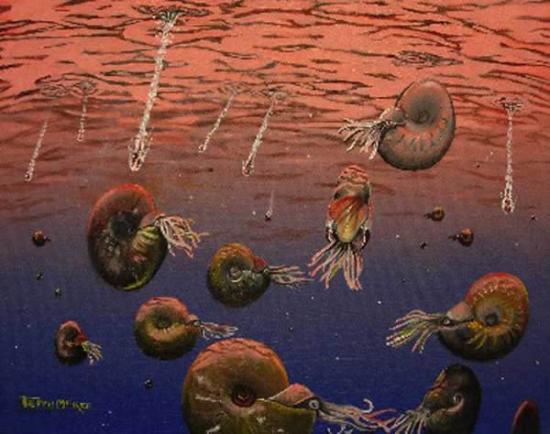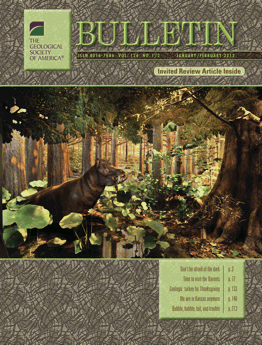大灭绝并非是突发事件?近日,一项十分细致的研究指出,二叠纪-三叠纪之交的那场大灭绝并不是突然爆发的,而是缓慢而渐进地使90%的海洋生物惨遭灭顶之灾。来自辛辛那提大学(University of Cincinnati)的T.Algeo与其他十多位合作者共同对北极圈内埃尔斯米尔岛(Ellesmere Island)的二叠-三叠系地层进行了高分辨率的研究,认为二叠纪生物大灭绝是一个持续了数百万年的过程。相关研究发表在Geological Society of America Bulletin上。

二叠纪海洋生态
2.5亿年前的二叠纪晚期,地球成了生命的荒漠。过去十年间,Algeo和同事们致力于寻找大灭绝期间,留在岩层中的各种化学成分。经过不懈的努力,我们终于能够一瞥那个奇异而恐怖的世界:酸雨的侵蚀让大地和海洋一片死寂,逸出的温室气体似乎将地球笼罩在了烤箱里。
研究者们所观察到的证据都指向西伯利亚大规模火山爆发事件。二叠纪晚期西伯利亚西部有多座火山喷发,火山灰沉积足有5千米厚,覆盖了相当于美国国土面积的区域,致命的熔岩四处流溢,并通过了一个有煤炭沉积的地层。

火山活动引发了长达百万年的二叠纪生物灭绝
“火山喷发与燃烧的煤炭释放出了大量甲烷,甲烷可以造成比二氧化碳严重30倍的温室效应。目前无法确定这次甲烷释放引起的温室效应持续了多久,但至少有数百万年。”Algeo称。
那次火山事件释放出的大量化学物质被雨水带到了海洋,固定在深海沉积物中。之前的研究主要集中在特提斯海(Tethys)沉积,二叠纪末期的特提斯海沉积记录了一次非常突然的生物灭绝现象,在中国南部的地层中尤为显著。“从浅海沉积来看,二叠纪末期的大灭绝确实非常突然,因此人们认为这是全球同时进行的突发事件。”他说。
然而新的证据对这一说法提出了质疑。Algeo提取了北极圈内的二叠纪末期沉积,这里更靠近西伯利亚火山群,更能还原真实情景。北极圈岛屿的沉积有24米厚,包含了二叠-三叠系的分界线。他们发现,在特提斯海沉积显示海洋生物灭绝之前的十万年,北极圈沉积就已经显示硅质海绵大面积死亡了。同时,地球化学信息显示,当时陆地生命也面临着严重威胁。植物残渣和遭到侵蚀的土壤被冲刷进海洋,有机物高度富集的海水缺少氧气,让海洋生物无法生存。
Algeo的研究认为,西伯利亚火山活动初期的一些现象,如释放有毒气体和火山灰等,其影响范围集中在大陆北端。当火山真正开始全力喷发时,才渐渐由北至南波及全球,引发了史上最惨烈的生物灭绝。

Evidence for a diachronous Late Permian marine crisis from the Canadian Arctic region
Thomas Algeo, Charles M. Henderson Brooks Ellwood, Harry Rowe, Erika Elswick, Steven Bates, Timothy Lyons, James C. Hower, Christina Smith, Barry Maynard, Lindsay E. Hays, Roger E. Summons, James Fulton and Katherine H. Freeman
A high-resolution chemostratigraphic study of a 24-m-thick section at West Blind Fiord on Ellesmere Island (Canadian Arctic) documents stepwise environmental deterioration in the marine Sverdrup Basin during the late Changhsingian (late Late Permian) as a result of volcanic disturbances to surrounding landmasses. A horizon within the upper Lindström Formation (datum A) is characterized by increased Fe-oxyhydroxide fluxes and weathering intensity as well as modest shifts toward more reducing water-mass conditions and higher marine productivity, recording an initial disturbance that washed soils into the marine environment. The contact between chert of the Lindström Formation and silty shale of the overlying Blind Fiord Formation, which is 1.6 m higher and ∼50 k.y. younger than datum A, records a large increase in detrital sediment flux, more strongly enhanced marine productivity, and a regional extinction of siliceous sponges, herein termed the “Arctic extinction event.” The horizon equivalent to the latest Permian mass extinction of Tethyan shallow-marine sections is 5.6 m higher and ∼100 k.y. younger than the Arctic extinction event, demonstrating the diachronous nature of the marine biotic and environmental crisis at a global scale; it is associated with intensified anoxia and possible changes in phytoplankton community composition in the study section. Marine environmental deterioration in the Sverdrup Basin, probably triggered by terrestrial ecosystem deterioration and elevated detrital sediment fluxes, was under way by the early part of the late Changhsingian, well before the onset of main-stage Siberian Traps flood basalt volcanism. The event sequence at West Blind Fiord may record the deleterious effects of early-stage explosive silicic eruptions that affected the Boreal region, possibly through deposition of toxic gas and ash within a restricted latitudinal band, while having little impact on marine ecosystems in the peri-equatorial Tethyan region.








